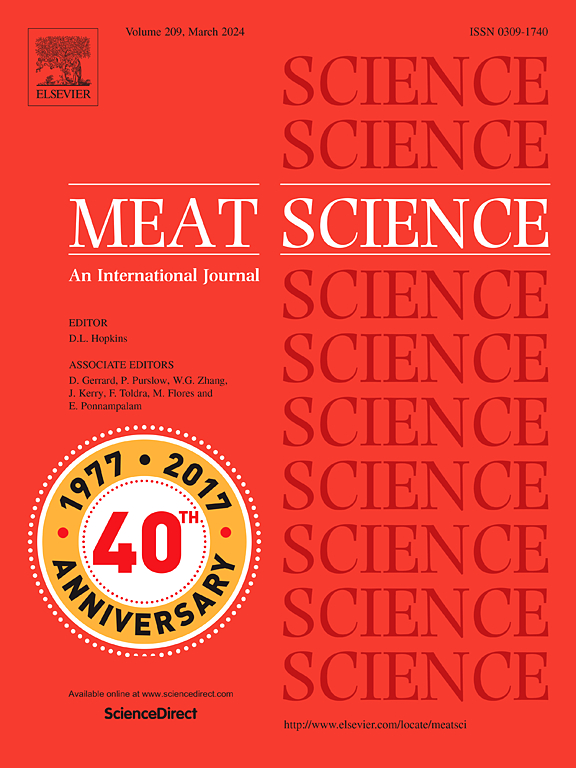Camel meat composition by species, breeds, publication year, age, and breeding system: A global systematic review and meta-analysis
IF 6.1
1区 农林科学
Q1 Agricultural and Biological Sciences
引用次数: 0
Abstract
Camel meat is increasingly being recognized as a sustainable and nutritious red meat source, particularly in arid and semi-arid areas where camels are thriving. However, its chemical composition and sensory attributes vary significantly owing to genetic, management, and environmental factors. This study conducted a systematic review and a meta-analysis to quantify the nutritional and sensory properties of camel meat and identify the key factors influencing these characteristics. A systematic review of peer-reviewed studies was conducted using Springer, PubMed/MEDLINE, Scopus, and ScienceDirect databases. This review comprised 57 papers published in English from 12 countries, covering the period between January 1991 and August 2024, including 377 analyses focusing on camel species, breeds, and breeding systems. Statistical analyses were performed to determine the effect sizes, heterogeneity, and impact of the moderating factors. The findings from our meta-regression and subgroup analyses revealed that variations in camel meat profiles are influenced by multiple factors, including breeding system, camel species, breeds, and age, but not by sex. Subgroup analysis revealed that higher final body weight (FBW) was reported for meat from Camelus bactrianus camels raised under the extensive system. Camels slaughtered at ≤6 years of age were characterized by higher dry matter, ash, and fat contents, but lower sarcomere length, lightness, redness, and cobalt content. The Najdi, Baladi Saudi, and Pakistani breeds were characterized as tender meat breeds. This study emphasizes the need for improved breeding strategies, meat processing techniques, and market awareness to enhance the appeal of camel meat. These findings provide valuable insights for livestock producers, policymakers, and the food industry, supporting the promotion of camel meat as a viable substitute for traditional red meat in regions affected by climate change and food insecurity.
骆驼肉的种类、品种、出版年份、年龄和饲养系统组成:一项全球系统综述和荟萃分析。
驼肉越来越被认为是一种可持续的、营养丰富的红肉来源,特别是在骆驼大量繁殖的干旱和半干旱地区。然而,由于遗传、管理和环境因素,其化学成分和感官属性差异很大。本研究通过系统综述和荟萃分析来量化骆驼肉的营养和感官特性,并确定影响这些特性的关键因素。使用施普林格、PubMed/MEDLINE、Scopus和ScienceDirect数据库对同行评议的研究进行系统评价。本综述包括来自12个国家的57篇英文论文,涵盖1991年1月至2024年8月期间,其中包括377篇关于骆驼种类、品种和繁殖系统的分析。进行统计分析以确定效应大小、异质性和调节因素的影响。meta-regression和亚组分析的结果显示,驼肉性状的变化受到多种因素的影响,包括繁殖系统、骆驼种类、品种和年龄,但不受性别的影响。亚群分析显示,粗放饲养的双歧驼肉的最终体重较高。≤6岁屠宰的骆驼干物质、灰分和脂肪含量较高,但肌节长度、亮度、红度和钴含量较低。Najdi, Baladi沙特和巴基斯坦品种的特点是嫩肉品种。本研究强调需要改进育种策略、肉类加工技术和市场意识,以提高骆驼肉的吸引力。这些发现为畜牧业生产者、政策制定者和食品行业提供了宝贵的见解,支持在受气候变化和粮食不安全影响的地区推广骆驼肉作为传统红肉的可行替代品。
本文章由计算机程序翻译,如有差异,请以英文原文为准。
求助全文
约1分钟内获得全文
求助全文
来源期刊

Meat Science
工程技术-食品科技
CiteScore
12.60
自引率
9.90%
发文量
282
审稿时长
60 days
期刊介绍:
The aim of Meat Science is to serve as a suitable platform for the dissemination of interdisciplinary and international knowledge on all factors influencing the properties of meat. While the journal primarily focuses on the flesh of mammals, contributions related to poultry will be considered if they enhance the overall understanding of the relationship between muscle nature and meat quality post mortem. Additionally, papers on large birds (e.g., emus, ostriches) as well as wild-captured mammals and crocodiles will be welcomed.
 求助内容:
求助内容: 应助结果提醒方式:
应助结果提醒方式:


